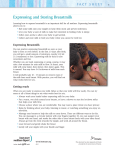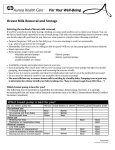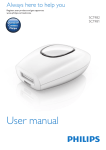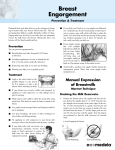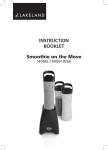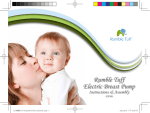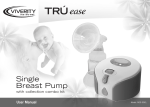Download Nurture III Instruction Manual 1
Transcript
NURTURE III BREAST PUMP INSTRUCTION MANUAL TABLE OF CONTENTS Care & Cleaning ..........................................................................................5 Assembly & Use ...........................................................................................6 Tips & Strategies for Successful Pumping.....................................................7 Storing Your Milk.........................................................................................9 Troubleshooting............................................................................................9 Ordering Parts & Accessories .....................................................................11 Warranty.....................................................................................................12 IMPORTANT SAFEGUARDS Basic safety precautions should always be followed when using electric appliances, especially when children are present. READ ALL INSTRUCTIONS BEFORE USING DANGER To reduce the risk of electrocution: • Always unplug this product immediately after use. • Do not use while bathing. • Do not place or store product where it can fall or be pulled into a tub or sink. • Do not place in or drop into water or other liquid. • Do not reach for a product that has fallen into the water. Unplug immediately. WARNING To reduce risks of burns, electrocution, fire, or injury to persons: • Product should never be left unattended when plugged in. • Close supervision is necessary when this product is used by, on, or near invalids or children. • Use this product only for its intended use as described in this manual. Do not use attachments not recommended by the manufacturer. • Never operate this product if it has a damaged cord or plug, if it is not working properly, if it has been dropped or damaged, or dropped into water. Return the product to our service center for examination and repair. When replacing the external fuse, please use a fuse of the same rating. • This appliance has a polarized plug (one blade is wider than the other). As a safety feature, this plug will fit in a polarized outlet only one way. If the plug does not fit fully in the outlet, reverse the plug. If it still does not fit, contact a qualified electrician. Do not attempt to defeat this safety feature. • Keep the cord and all parts away from heated surfaces. • Never block the air openings of the product or place it on a surface, such as a bed or couch, where the air openings may be blocked. Keep the air openings free of lint, hair and the like. • Never use while sleepy or drowsy. • Never drop or insert any object into any opening or hose. • Do not use outdoors or operate where aerosol (spray) products are being used or where oxygen is being administered. • For household use only. SAVE THESE INSTRUCTIONS [2] C ongratulations on your decision to breastfeed your child. Breast milk is the only perfect baby food and we know how important it is for your baby to have a good start. That’s why we’ve designed the Nurture III Double Electric Breast Pump to be a convenient and reliable way for you to ensure that your precious breast milk is available to your baby, even when you must be apart. [3] COMPONENTS OF THE NURTURE III DOUBLE ELECTRIC BREAST PUMP The Nurture III is an efficient, reliable breast pump designed to meet the needs of nursing women who are going back to part-time or full-time work or school. It can also be used to relieve engorgement or maintain an established lactation if breastfeeding is interrupted. 10 11 8 6 2 6 2 3 3 1 4 4 5 12 5 8 7 9 1 Pump Motor 7 Single Cap 2 Flange 8 Filter 3 Flange Base 9 O-Ring 4 Bottle 10 Short Tube 5 Bottle Stand 11 Long Tube (includes Luer Fitting) 6 Double Cap 12 Bottle Cap (2-piece) [4] CARE & CLEANING Always wash your hands before touching your breasts or the breast pump parts. Try not to touch the inside surfaces of the parts. It is not usually necessary to sterilize the collection set parts, but they must be clean when you use them. DO NOT WASH THE FILTERS OR PUT THEM IN WATER! Before your first use of the pump and after every use, disassemble all the parts of the collection set. Wash the bottles, flanges, flange bases, o-rings, purple caps, and bottle stands in warm soapy water, rinse well, and let the parts air-dry. If milk gets into the tubes, they should also be washed and rinsed. It is not necessary to remove the luer fitting from the end of the long tube. To get water out of your tubes, twirl them around like a propeller, then hang them up to dry. If you wish to further sanitize your parts, they may be placed in a boiling water bath for up to 3 minutes. Boiling your parts may cause them to become cloudy and the printing might come off the bottles, but it will not impair their function. The parts are dishwasher safe if placed on top rack away from the heating element.We do not recommend using microwave sterilization bags. Again, DO NOT WASH THE FILTERS OR PUT THEM IN WATER! The filter protects your pump motor by keeping milk out of it. If the filter gets water or condensation in it, you will no longer get suction until it dries. Once the filter gets clogged with milk, is washed, or used for three weeks or longer and gets clogged, the filter will have to be replaced. To order more filters, call 1-800-413-3216. Keep the pump motor dry. Store it in a clean, dry, well-ventilated place when not in use. To clean the motor, unplug it and wipe with a clean damp cloth. Do not immerse the pump in water or use the pump while you are in water. The pump motor has no user-serviceable parts. Do not remove the cover. Contact our customer service department for servicing. The insulated tote may be wiped clean with a damp cloth. [5] ASSEMBLY & USE Before you use the pump, wash all the parts EXCEPT the motor, the filters, and the tubes. (See instructions under “Care & Cleaning”). DO NOT WASH THE FILTER! • Insert the flange securely into the flange base as shown. Twisting the flange as you put it in and take it out will help. • Put the o-ring into the flange base, then screw the bottle on. • For single pumping, use the single cap. For double pumping, use the two double caps. Press or twist the cap firmly on top of the flange base. • For double pumping, put one end of the short tube over each of the ‘stems’ on the double caps. • Connect the long tube to the stem on the side of the motor. Insert the blue side of the filter in the fitting in the long tube and put the clear side of the filter into the hole in the cap. If you are double pumping, the filter can go into either one of the caps. • Plug in the motor, switch it on, and turn the purple knob to the the left. Please note: If the knob is turned all the way to the right and is screwed in all the way, there will be no suction. For stronger suction, turn the purple knob more to the left. * Older Nurture III motors have just one knob that controls both power and suction. [6] • Holding the bottles upright, center your nipples in the flange openings and hold the flanges against your breasts. Cover the open hole in the purple cap with your finger or thumb to create suction. Roll or lift your finger or thumb off the hole every 2–4 seconds to cycle the pump. For stronger suction turn the purple knob to the left. For less suction turn the knob to the right. Do not cover the hole for longer than 4 seconds. If the pump doesn’t work: • Always use an o-ring between the bottle and the flange base and make sure the bottle and flange base are connected tightly. • Use the bottles that come with the kit to ensure a perfect match with the flange base. • Be sure to cover the hole in the purple cap with your finger or thumb. • Hold the flange against your breast, making sure there is no clothing or fabric between your skin and the flange. • If milk or water has clogged your filter, typically it won't work. You can let it dry and try it again, use a different one or order a new one. • Refer to the “Troubleshooting” section of this manual. Please call us if you need help! 1-800-413-3216. Safety Precautions • WARNING: if pumping is painful for you, stop pumping. Please contact Bailey immediately and get help from a lactation consultant or other health-care professional. • Do not use the Nurture III if you are unable to express milk with it. • If the flange feels too tight use a larger flange. • Do not cover the hole in the cap for longer than 4 seconds. • If your nipples become swollen or discolored, do not continue pumping. • Do not wrap the cord around the motor. Do not use if the cord is worn, cut, torn or frayed. TIPS & STRATEGIES FOR SUCCESSFUL PUMPING You can take advantage of the let down you get for your baby and teach yourself to let down for the pump by single pumping one side while your baby nurses on the other side. Many mothers find this an easy way to get used to pumping. Be sure to switch sides occasionally, so both breasts get equal stimulation. [7] Pumping both breasts at the same time (double pumping) cuts pumping time in half and raises prolactin levels, stimulating greater milk production. When your milk flow slows or stops, take a break for a few minutes or change sides. Switching back-and-forth from one breast to the other will bring more milk. Practice using your breast pump in a non-stressful environment for a few weeks before you become dependent on pumping. Do not attempt to pump before your baby is born and your milk comes in unless you are advised to do so by a lactation consultant or other knowledgeable health-care professional. You can simulate your baby’s nursing pattern by cycling the pump rapidly at first (about once a second) and then settling into longer suction intervals of 3 to 4 seconds once your milk starts flowing. To assist the milk ejection reflex (“let down”) when you are separated from your baby: • Relax and congratulate yourself on doing such a wonderful thing for your baby. • Minimize distractions and allow enough time so you won’t feel rushed. • Look at a photograph of (or try to visualize) your baby while you pump. Use all your senses! Try smelling something your baby wore recently or listening to a tape of your baby’s cry when s/he’s hungry. • Massage your breasts, using a circular motion similar to that used in breast examination. • Using a light touch, stroke your breast toward the nipple. • Lean forward and shake your breasts from side to side. • Try using our Flexishield TM soft silicone flange inserts that massage your areolas as you pump. • Try using our Super Shields, which fit into your flange set and eliminate constriction of milk ducts to promote better flow and reduce irritation to the nipple area. • Focus on something else. Read, talk on the phone or watch TV. [8] STORING EXPRESSED BREAST MILK Breast milk storage guidelines are frequently updated. For the latest recommendations, call a lactation consultant or your local La Leche League Leader. To inhibit the growth of bacteria, expressed breast milk that is not used immediately should be refrigerated or frozen. You may store your expressed milk in the bottles that you pumped into, or transfer the breast milk to another bottle or Milk Storage Bag. If the breast milk is going to be frozen, do not fill the container more than 3/4 full. Write the date on the container so you can use the oldest milk first. If you will be sending expressed milk to a day-care facility with your baby, also write your baby’s name on the container. Our Insulated Tote will keep up to six bottles of your expressed breast milk cold until it can be used or refrigerated if the ice pack is frozen solid. Breast milk will keep 4 to 6 hours at room temperature, 5 to 7 days in the refrigerator, two weeks in a freezer compartment inside the refrigerator, or up to four months in a freezer with a separate outside door. Each collection of breast milk should be cooled separately. Never mix warm milk with cold milk. It’s OK to combine two bottles of cooled milk. Cooled fresh milk can be combined with frozen milk if there is less fresh milk than frozen milk. If you freeze your milk in 2- to 4-ounce portions, it will thaw quickly and there will be less waste if your baby doesn’t drink the whole portion. Never refreeze breast milk. Thawing Frozen Breast Milk or Warming Cooled Breast Milk Be sure to use the oldest milk first. Place the sealed container of frozen milk in a bowl of cool, then warm water for about 30 minutes, or hold it under cool, then warm, running water to thaw. Swirl the container occasionally to reblend any fat that may separate while the milk is thawing. Do not microwave or boil breast milk. You can feed thawed milk to your baby immediately or store it in the refrigerator for up to 24 hours. TROUBLESHOOTING There’s not enough suction It is unusual for anything to go wrong with the motor unless milk gets into it. If the motor turns on and sounds the same as it usually does, the problem is probably somewhere in your collection set. [9] • Remember to cover the hole in the purple cap with your finger or thumb to create suction. • Be sure that the flange (both flanges if you’re double pumping) is held firmly against your breast. • Double check to make sure that the o-ring is seated properly between the flange and bottle, that all the tubing connections are snug, and that the purple caps and flanges are securely in place. Sometimes it helps to try each collection cup separately; if you get suction in one, but not the other, then you know to look for a problem in the one with no suction. Try taking the o-ring out and putting it in again. • Replace the filter. Your filter will probably need to be replaced about once every four to six weeks—more often if a bottle spills or gets over-filled. If you still can’t get the pump to work, call Bailey for assistance at 1-800413-3216. Have the pump and all the parts handy when you call, be near an outlet where you can plug the pump in, and allow about 10 minutes for us to go through the pump with you to identify the problem. DO NOT ATTEMPT TO REPAIR THE PUMP MOTOR YOURSELF. Doing so will void the warranty. You aren’t getting enough milk Remember that milk production is a function of supply and demand. The more your baby breastfeeds or the more you pump, the more milk you will produce. To maintain your milk supply, you should pump at least once every 2–3 hours that you are separated from your baby. Don’t worry if you don’t get much milk the first few times you use the pump. Keep practicing, using the techniques suggested in the “Tips & Strategies For Successful Pumping” section (page 7), and soon you will be able to express more. Giving young babies supplements of water or formula, or starting older babies on solid foods will decrease your milk supply. To increase your milk production, breastfeed more, pump more often, or pump and breastfeed at the same time. [10] There is water or milk in the tubes or filter The water vapor that may develop in your tubes and filter while you pump is not uncommon and it will not harm your pump motor. Disconnect the filter and tubes when you are finished pumping and shake the water out by twirling the tubes around like a propeller, then store the parts so that air can circulate (try our Air Dry Accessory Bag). If the filter gets really wet, it might take a few hours to dry out. You may want to try using two filters, alternating between them so that each one can dry completely between pumping sessions. You can minimize the condensation that develops by keeping your parts at room temperature (not in the tote near the ice pack!) and making sure they are dry before you begin pumping. To prevent milk from getting into the filter or short tube: • Do not overfill the collection bottle(s). • Do not try to pump into plastic bags with the Nurture III. • Be sure to hold the bottles upright. • Make sure the o-ring is seated properly. • Use the bottle stands. The purpose of the filter is to keep milk out of your pump motor. Never use the pump without a filter. If milk gets into the filter, the filter will need to be replaced soon. It is not necessary to replace the filter until you lose suction or you begin to see dark spots in it. If milk gets into your pump motor, the motor will need to be repaired. Using the pump without a filter or attempting to repair the motor yourself voids the warranty. If milk gets in the short tube, wash it out with warm water when you finish pumping, then rinse and shake the water out and hang the tube to dry. No milk can get into the long tube if the filter is always used. ORDERING PARTS & ACCESSORIES Parts and accessories for the Nurture III may be available where you purchased your pump or you can order them from Bailey by calling our Customer Service Department at 1-800-413-3216 or by visiting our website at www.baileymed.com. We accept VISA, MasterCard and Discover. The Nurture III pump motor is approved by the FDA as safe for multiple users. Each person who uses the pump should have her own Double Collection Kit. [11] WARRANTY The Nurture III Double Electric Breast Pump is warranted to the original retail purchaser for 5 years from date of purchase against defects in material and workmanship. This warranty does not cover defects arising from misuse, abuse, accident, alterations, damage in transit, or failure to use according to instructions. If defective, the unit will be repaired or replaced. Filters are not covered by this warranty. Filters are an expendable part that may need to be replaced every four to six weeks. If you should have problems with the pump, refer to the “Troubleshooting” section of this manual or call Bailey for assistance at 1-800-413-3216. If your pump is out of warranty and you’re having trouble with it, call us! We will be happy to repair your motor for a small fee. [12]














